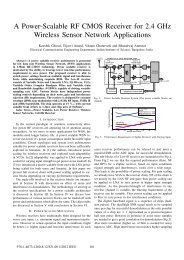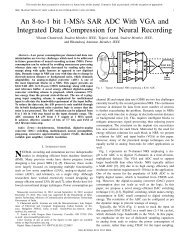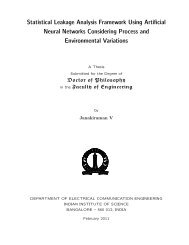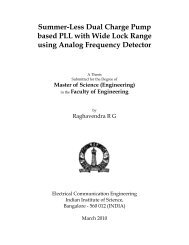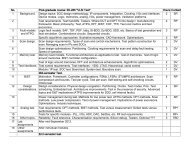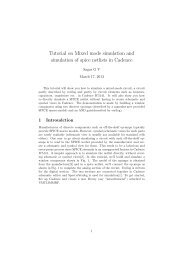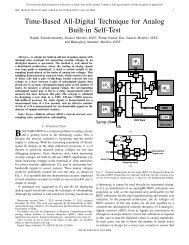NoC design and optimization for Multi-core media processors
NoC design and optimization for Multi-core media processors
NoC design and optimization for Multi-core media processors
You also want an ePaper? Increase the reach of your titles
YUMPU automatically turns print PDFs into web optimized ePapers that Google loves.
CHAPTER 3. LINK MICROARCHITECTURE EXPLORATION 33Intacte [82] provides a similar capability to explore link level <strong>design</strong> options <strong>and</strong> is usedin this research.It is clear from a<strong>for</strong>ementioned works that there is a need <strong>for</strong> a co-<strong>design</strong> of interconnects,processing elements <strong>and</strong> memory blocks to fully optimize the overall system-on-chipper<strong>for</strong>mance. This necessitates a simulation framework which allows a co-simulation ofthe communicating entities along with ICN simulation. Additionally, to optimize powerfully, one also needs to incorporate the link-level microarchitectural choices of pipeliningetc. A System-C framework which enables <strong>NoC</strong> <strong>design</strong>ers to assemble communicatingentities along with the ICN <strong>and</strong> also allows <strong>for</strong> exploration of architectural <strong>and</strong> microarchitecturalparameters of the ICN in order to obtain the latency, throughput <strong>and</strong> powertrade-offs has been developed <strong>and</strong> is presented in Section 3.2.Further, previous works largely concentrate on router power <strong>and</strong> do not take intoaccount various link microarchitectural parameters <strong>for</strong> power <strong>and</strong> per<strong>for</strong>mance trade-offcalculations. This chapter presents results <strong>for</strong> <strong>NoC</strong> power by considering effects of variouspipelining configurations, frequency <strong>and</strong> voltage scaling values. Various traffic generation<strong>and</strong> distribution models have been used to mimic realistic traffic patterns <strong>and</strong> activity in<strong>NoC</strong>s. Trade-off studies in this chapter consider Energy-Delay product of the <strong>NoC</strong> as the<strong>optimization</strong> parameter.3.2 <strong>NoC</strong> Microarchitectural Exploration FrameworkThe <strong>NoC</strong> exploration framework (Figure 3.1) has been built upon Open Core Protocol-IPmodels[125] using OSCI SystemC 2.0.1[126] on Linux (2.6.8-24.25-default). The frameworkcontains Router, Link <strong>and</strong> Processing Element (PE) modules <strong>and</strong> each can be customizedviavariousparameters.The<strong>NoC</strong>modulescanbeinterconnectedto<strong>for</strong>madesired<strong>NoC</strong>. The PE module represents any communicating entity on the SoC <strong>and</strong> not just theprocessing element. We can connect an actual executable model of the entity or someabstract model representing its communication characteristics. For abstract models, wesupport many different traffic generation <strong>and</strong> communication patterns. The link modulecan be used to customize the bit-width of the links as well as the degree of pipelining




